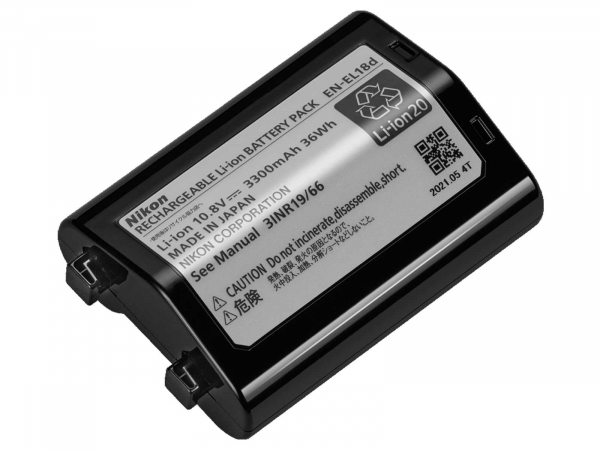| Type |
| |
| Mirrorless |
| |
| Lens mount |
| |
| Nikon Z mount |
| |
| Image sensor |
| |
| FX, CMOS, 35.9 mm x 23.9 mm |
| |
| Total pixels |
| |
| 52.37 million |
| |
| Dust-reduction system |
| |
| Image sensor cleaning, Image Dust Off reference data (requires NX Studio) |
| |
| Effective pixels |
| |
| 45.7 million |
| |
| Image size (pixels) |
| |
| [FX (36 x 24)] selected for image area: (L) 8256 x 5504 (45.4 million), (M) 6192 x 4128 (25.6 million), (S) 4128 x 2752 (11.4 million), [DX (24 x 16)] selected for image area: (L) 5392 x 3592 (19.4 million), (M) 4032 x 2688 (10.8 million), (S) 2688 x 1792 (4.8 million), [1:1 (24 x 24)] selected for image area: (L) 5504 x 5504 (30.3 million), (M) 4128 x 4128 (17.0 million), (S) 2752 x 2752 (7.6 million), [16:9 (36 x 20)] selected for image area: (L) 8256 x 4640 (38.3 million), (M) 6192 x 3480 (21.5 million), (S) 4128 x 2320 (9.6 million) |
| |
| Storage file formats |
| |
| NEF (RAW): 14 bit; choose from lossless compression, high efficiency (high), and high efficiency options, JPEG: JPEG-Baseline compliant with fine (approx. 1:4), normal (approx. 1:8), or basic (approx. 1:16) compression; size-priority and optimal-quality compression available, NEF (RAW)+JPEG: Single photograph recorded in both NEF (RAW) and JPEG formats |
| |
| Picture Control System |
| |
| Auto, Standard, Neutral, Vivid, Monochrome, Portrait, Landscape, Flat, Creative Picture Controls (Dream, Morning, Pop, Sunday, Somber, Dramatic, Silence, Bleached, Melancholic, Pure, Denim, Toy, Sepia, Blue, Red, Pink, Charcoal, Graphite, Binary, Carbon); selected Picture Control can be modified; storage for custom Picture Controls |
| |
| Storage media |
| |
| CFexpress XQD |
| |
| Dual card slot |
| |
| 2 CFexpress cards or XQD cards, The card in Slot 2 can be used for overflow or backup storage, for separate storage of NEF (RAW) and JPEG pictures, or for storage of duplicate JPEG pictures at different sizes and image qualities; pictures can be copied between cards. |
| |
| File system |
| |
| DCF 2.0, Exif 2.32 |
| |
| Viewfinder |
| |
| 1.27-cm/0.5-in. approx. 3690k-dot (Quad VGA) OLED electronic viewfinder with color balance and auto and 16-level manual brightness controls |
| |
| Frame coverage |
| |
| Approx. 100% horizontal and 100% vertical |
| |
| Magnification |
| |
| Approx. 0.8x (50 mm lens at infinity, -1.0 m-¹) |
| |
| Eyepoint |
| |
| 23 mm (-1.0 m-¹; from rearmost surface of viewfinder eyepiece lens) |
| |
| Diopter adjustment |
| |
| -4 - +3 m-¹ |
| |
| Eye sensor |
| |
| Automatically switches between monitor and viewfinder displays |
| |
| Compatible lenses |
| |
| Z mount NIKKOR lenses F mount NIKKOR lenses (mount adapter required; restrictions may apply) |
| |
| Shutter type |
| |
| Electronic shutter with shutter sound and sensor shield |
| |
| Shutter speed |
| |
| 1/32000 to 30 s (choose from step sizes of 1/3, 1/2, and 1 EV, extendable to 900 s in mode M), bulb, time |
| |
| Flash sync speed |
| |
| Flash synchronizes with shutter at speeds of 1/250 or 1/200 s or slower (but note that the guide number drops at speeds of 1/200 to 1/250 s); sync speeds as fast as 1/8000 s are supported with auto FP high-speed sync |
| |
| Release mode |
| |
| S (single frame), CL (continuous low-speed), CH (continuous high-speed), High-speed frame capture, Self-timer |
| |
| Frame advance rate12 |
| |
| Up to 120 fps, Continuous low-speed: Approx. 1 to 10 fps, Continuous high-speed: Approx. 10 to 20 fps, High-speed frame capture (C30): Approx. 30 fps, High-speed frame capture (C120): Approx. 120 fps |
| |
| Self-timer |
| |
| 2 s, 5 s, 10 s, 20 s; 1 to 9 exposures at intervals of 0.5, 1, 2, or 3 s |
| |
| Exposure metering |
| |
| TTL metering using camera image sensor |
| |
| Metering method |
| |
| Matrix metering, Center-weighted metering: Weight of 75% given to 12 or 8 mm circle in center of frame or weighting can be based on average of entire frame, Spot metering: Meters circle with a diameter of approximately 4mm centered on selected focus point, Highlight-weighted metering |
| |
| Metering range13 |
| |
| -3 to +17 EV |
| |
| Mode |
| |
| P: programmed auto with flexible program, S: shutter-priority auto, A: aperture-priority auto, M: manual |
| |
| Exposure compensation |
| |
| -5 to +5 EV (choose from step sizes of 1/3 and 1/2 EV) |
| |
| Exposure lock |
| |
| Luminosity locked at detected value |
| |
| ISO sensitivity |
| |
| ISO 64 to 25600, in steps of 1/3 and 1EV, can also be set to approx. 0.3, 0.7, or 1 EV (ISO 32 equivalent) below ISO 64 or to approx. 0.3, 0.7, 1, or 2 EV (ISO 102400 equivalent) above ISO 25600; auto ISO sensitivity control available (Recommended Exposure Index) |
| |
| Active D-Lighting |
| |
| Auto, Extra high 2, Extra high 1, High, Normal, Low, and Off |
| |
| Multiple exposure |
| |
| Add, average, lighten, darken |
| |
| Other options |
| |
| HDR overlay, photo mode flicker reduction |
| |
| Autofocus |
| |
| Hybrid phase-detection/contrast AF with AF assist |
| |
| Detection range14 |
| |
| -6.5 to +19 EV (-8.5 to +19 EV with starlight view) |
| |
| Lens servo |
| |
| Single-servo AF (AF-S), Continuous-servo AF (AF-C), full-time AF (AF-F; available only in video mode); predictive focus tracking, Manual focus (M): Electronic rangefinder can be used |
| |
| Focus points15 |
| |
| 493 |
| |
| AF-area mode |
| |
| Pinpoint (available in photo mode only), single-point, dynamic-area (S, M, and L; available in photo mode only), wide-area (S and L), and auto-area AF, 3D-tracking (available in photo mode only), subject-tracking AF (available in video mode only) |
| |
| Focus lock |
| |
| Focus can be locked by pressing shutter-release button halfway (single-servo AF/AF-S) or by pressing the center of the sub-selector |
| |
| Camera VR |
| |
| 5-axis image sensor shift |
| |
| Lens VR |
| |
| Lens shift (available with VR lenses) |
| |
| Flash control |
| |
| TTL: i-TTL flash control; i-TTL balanced fill-flash is used with matrix, center-weighted, and highlight-weighted metering, standard i-TTL fill-flash with spot metering |
| |
| Flash modes |
| |
| Front-curtain sync, slow sync, rear-curtain sync, red-eye reduction, red-eye reduction with slow sync, off |
| |
| Flash compensation |
| |
| -3 to +1 EV in steps of 1/3 or 1/2 EV |
| |
| Flash-ready indicator |
| |
| Lights when optional flash unit is fully charged; flashes as underexposure warning after flash is fired at full output |
| |
| Accessory shoe |
| |
| ISO 518 hot-shoe with sync and data contacts and safety lock |
| |
| Nikon Creative Lighting System |
| |
| i-TTL flash control, radio-controlled Advanced Wireless Lighting, optical Advanced Wireless Lighting, modeling illumination, FV lock, Color Information Communication, auto FP high-speed sync, unified flash control |
| |
| Sync terminal |
| |
| ISO 519 sync terminal with locking thread |
| |
| White balance |
| |
| Auto (3 types), natural light auto, direct sunlight, cloudy, shade, incandescent, fluorescent (3 types), flash, choose color temperature (2500 to 10,000 K), preset manual (up to 6 values can be stored), all with fine-tuning |
| |
| Bracketing types |
| |
| Exposure and/or flash, white balance, ADL |
| |
| Movie - metering |
| |
| TTL exposure metering using main image sensor, TTL metering using camera image sensor |
| |
| Movie - metering method |
| |
| Matrix, center-weighted, or highlight-weighted |
| |
| Movie - frame size (pixels) and frame rate16 |
| |
| 7680 x 4320 (8K UHD): 30p (progressive)/25p/24p, 3840 x 2160 (4K UHD): 120p/100p/60p/50p/30p/25p/24p, 1920 x 1080: 120p/100p/60p/50p/30p/25p/24p |
| |
| Movie - file format |
| |
| MOV, MP4 |
| |
| Movie - video compression |
| |
| Apple ProRes 422 HQ (10 bit), H.265/HEVC (8 bit/10 bit), H.264/AVC (8 bit) |
| |
| Movie - audio recording format |
| |
| Linear PCM (for videos recorded in MOV format), AAC (for videos recorded in MP4 format) |
| |
| Movie - audio recording device |
| |
| Built-in stereo or external microphone with attenuator option; sensitivity adjustable |
| |
| Movie - exposure compensation |
| |
| -3 to +3 EV (choose from step sizes of 1/3 and 1/2 EV) |
| |
| Movie - ISO sensitivity |
| |
| Mode M: Manual selection (ISO 64 to 25600; choose from step sizes of 1/3 and 1 EV); with additional options available equivalent to approximately 0.3, 0.7, 1, or 2 EV (ISO 102400 equivalent) above ISO 25600; auto ISO sensitivity control (ISO 64 to Hi 2.0) available with selectable upper limit, Modes P, S, A: Auto ISO sensitivity control (ISO 64 to Hi 2.0) with selectable upper limit (Recommended Exposure Index) |
| |
| Movie - Active D-Lighting |
| |
| Extra high, High, Normal, Low, and Off |
| |
| Movie - Other options |
| |
| Time-lapse video recording, electronic vibration reduction, time codes, N-Log and HDR (HLG) video |
| |
| Monitor |
| |
| 8-cm (3.2–in.) diagonal; vertically and horizontally tilting TFT touch-sensitive LCD with 170° viewing angle, approximately 100% frame coverage, and color balance and 11-level manual brightness controls; Approx. 2100k-dot |
| |
| Playback |
| |
| Full-frame and thumbnail (up to 4, 9, or 72 pictures) playback with playback zoom, playback zoom cropping, video playback, histogram display, highlights, photo information, location data display, auto picture rotation, picture rating, voice memo input and playback, and IPTC information embedding and display |
| |
| USB |
| |
| Type C USB connector (SuperSpeed USB); connection to built-in USB port is recommended |
| |
| HDMI output |
| |
| Type A HDMI connector |
| |
| Audio input |
| |
| Stereo mini-pin jack (3.5 mm diameter; plug-in power supported) |
| |
| Audio output |
| |
| Stereo mini-pin jack (3.5 mm diameter) |
| |
| Ten-pin remote terminal |
| |
| Built-in (can be used with MC-30A/MC-36A remote cords and other optional accessories) |
| |
| Ethernet |
| |
| RJ-45 connector Standards: IEEE 802.3ab (1000BASE-T), IEEE 802.3u (100BASE-TX), IEEE 802.3 (10BASE-T) Data rates17: 1000/100/10 Mbps with auto detect, Port: 1000BASE-T/100BASE-TX/10BASE-T (AUTO-MDIX) |
| |
| Wi-Fi (Wireless LAN) standards |
| |
| IEEE 802.11b/g/n/a/ac |
| |
| Wi-Fi (Wireless LAN) operating frequency |
| |
| 2412 to 2462 MHz (channel 11) and 5180 to 5320 MHz |
| |
| Wi-Fi (Wireless LAN) maximum output power |
| |
| 2.4 GHz band: 8.4 dBm 5 GHz band: 9.0 dBm |
| |
| Wi-Fi (Wireless LAN) security |
| |
| Open system, WPA2-PSK, WPA3-SAE |
| |
| Bluetooth standards |
| |
| Bluetooth Specification version 5.0, Bluetooth: 2402 to 2480 MHz, Bluetooth Low Energy: 2402 to 2480 MHz, Bluetooth: 2.9 dBm, Bluetooth Low Energy: 1.4 dBm, Range (line of sight): approximately 10 m (32 ft)18 |
| |
| Supported GNS systems |
| |
| GPS (USA), GLONASS (Russia), QZSS (Japan) |
| |
| Data acquired |
| |
| Latitude, longitude, altitude, UTC (Universal Coordinated Time) |
| |
| Clock synchronization |
| |
| Camera clock can be set to time acquired via GNSS |
| |
| Track logs |
| |
| NMEA-compliant |
| |
| Log interval |
| |
| 15 s, 30 s, 1 min., 2 min., 5 min. |
| |
| Maximum log recording time |
| |
| 6, 12, or 24 hours |
| |
| Log deletion |
| |
| Supported |
| |
| Battery |
| |
| One EN-EL18d rechargeable Li-ion battery, EN-EL18c, EN-EL18b, EN-EL18a, and EN-EL18 batteries can also be used. Note, however, that fewer pictures can be taken on a single charge than with the EN-EL18d. The EH-7P charging AC adapter can be used to charge EN-EL18d, EN-EL18c, and EN-EL18b batteries only. |
| |
| AC adapter |
| |
| EH-7P charging AC adapter; EH-6d; requires EP-6a power connector (available separately) |
| |
| Tripod socket |
| |
| 0.635 cm (1/4 in., ISO 1222) |
| |
| Dimensions (W x H x D) |
| |
| Approx. 149 x 149.5 x 90.5 mm (5.9 x 5.9 x 3.6 in.) |
| |
| Weight |
| |
| Approx. 1340 g (2 lb. 15.3 oz.), with battery and memory card but without body cap and accessory shoe cover; approx. 1160 g/2 lb. 9 oz. (camera body only) |
| |
| Operating environment - temperature |
| |
| -10 °C to 40 °C (+14 °F to 104 °F) |
| |
| Operating environment - humidity |
| |
| 85% or less (no condensation) |
| |
| Supplied accessories |
| |
| BF-N1 Body Cap, EN-EL18d Rechargeable Li-ion Battery with Terminal Cover, MH-33 Battery Charger, EH-7P Charging AC Adapter (supplied with a plug adapter attached in countries or regions where required; shape depends on country of sale), HDMI/USB Cable Clip, AN-DC24 Strap, UC-E24 USB Cable, BS-1 Accessory Shoe Cover (comes attached to camera) |
| |
| ¹ You can shoot at C120 (120 fps, 11 MP, JPEG normal/small) in FX format only. You can shoot at C30 (30 fps, 45MP, JPEG normal/large) and at 20 fps (RAW and JPEG) in FX or DX format. Full AF/AE tracking is available for all frame rates and file sizes. |
| ² 1000 full-resolution images at 20 fps (RAW and JPEG) in FX or DX format in one burst can be achieved when using ProGrade Digital Cobalt CFexpress cards (as per October 2021). |
| ³ Among full-frame mirrorless cameras as of October 2021. Based on Nikon research. |
| ⁴ Working remotely with a single Z 9 tethered to a smartphone requires use of Nikon’s NX MobileAir software application. Working remotely with multiple cameras via a tethered 4G/5G network requires use of the NX Field software application. |
| ⁵ The Z 9 can record 8K/30p video for up to 125 minutes at a time. |
| ⁶ A firmware update (available spring 2022) is required to enable in-camera 8K/60p video recording. |
| ⁷ Recording in N-RAW is only possible following a firmware update (available spring 2022). |
| ⁸ Recording in ProRes RAW HQ is only possible following a firmware update (available spring 2022). |
| ⁹ 4K UHD video oversampled from 8K is possible when recording in 30p/25p/24p. A firmware update (available spring 2022) is required to oversample from 8K when recording in 50p/60p footage. |
| ¹⁰ 8K still frames are saved as JPEG files at the [frame size/frame rate] dimensions selected in the video recording menu when the video was recorded. |
| ¹¹ Based on CIPA standards. |
| ¹² Maximum frame advance rate as measured by in-house tests. |
| ¹³ Figures are for ISO 100 and f/2.0 lens at 20 °C/68 °F. |
| ¹⁴ Measured in photo mode at ISO 100 and a temperature of 20 °C/68 °F using single-servo AF (AF-S) and a lens with a maximum aperture of f/1.2. |
| ¹⁵ Number of focus points available in photo mode with single-point AF selected for AF-area mode and FX selected for image area. |
| ¹⁶ Actual frame rates for 120p, 100p, 60p, 50p, 30p, 25p, and 24p are 119.88, 100, 59.94, 50, 29.97, 25, and 23.976 fps respectively. |
| ¹⁷ Maximum logical data rates according to IEEE standard; actual rates may differ. |
| ¹⁸ Without interference. Range may vary with signal strength and presence or absence of obstacles. |
| Unless otherwise stated, all measurements are performed in conformity with Camera and Imaging Products Association (CIPA) standards or guidelines. |
| All figures are for a camera with a fully-charged battery. |
| The sample images displayed on the camera and the images and illustrations in these specifications are for expository purposes only. |
| Nikon reserves the right to change the appearance and specifications of the hardware and software described in this document at any time and without prior notice. Nikon will not be held liable for damages that may result from any mistakes that these specifications may contain. |
| |
| |
| Material code |
| Z 9 - VOA082AE |










